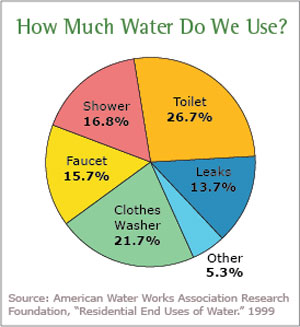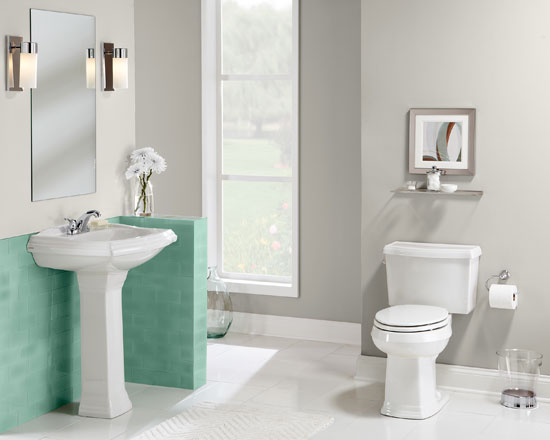Selecting Better Toilets by Design
The early 1900s saw the design of flush toilets begin to take the form we are familiar with today. Several inventors and manufacturers focused on the use of porcelain as the dominant material for both the bowl and the now closely aligned water tank. They developed variations in the way that they worked, the internal mechanisms that allowed water to flow and stop (i.e. flush), and integrated the curving plumbing trap into the bottom outlet to allow water to remain in the bowl afterwards. For decades, their acceptance, use, and sheer numbers grew to the point where they became commodities that were first expected and then required by code in every habitable building in the U.S. With a common perception that water was abundant and available and all buildings could be connected to underground infrastructure for treatment, there was little need to worry too much about efficiency, just functionality.
Regulations and Standards

Image: U.S. Environmental Protection Agency
Water use in a typical American home is attributed to several categories, but the largest single one is from the use of flush toilets.
Things began to change in the 1970s following the oil embargo when the first Energy Policy and Conservation Act was passed by Congress and signed into law in 1975. This legislation acknowledged that not only was energy a valuable resource that needed to be addressed, but so was water. There are two reasons for this. First, most potable water requires a significant amount of energy to pump, move, treat, process, and deliver to consumers. Only a small fraction of this water is actually consumed by people through drinking or cooking. For example, most residential water is used for washing, showering, and flushing which all typically then require more energy for removing, processing, and treating it before returning the water back to the environment. According to government studies, the average American family of four uses 400 gallons of water per day with approximately 70 percent of that water being used indoors. Bathrooms are identified as being the largest consumer with a toilet alone found to use 27 percent of the water! Hence, reducing the amount of water required by a household, and toilets in particular, directly reduces the amount of energy used to first deliver and then to recover that water. Second, as populations have increased in certain areas of the U.S., the demand for water has also increased to the point where it is exceeding the available reliable supply. In some cases, those supplies are already being disputed for territorial control. The combination of increasing water scarcity and the energy requirements of processing water in aging infrastructure systems have driven the logical inclusion of water conservation in energy legislation ever since.
In 1992, the United States Congress passed the Energy Policy Act, which mandated that beginning in 1994 common flush toilets were only to use only 1.6 US gallons (6.1 L) of water per flush instead of the more common 3.5 gallons at the time. These were sometimes referred to as Ultra Low Flow (ULF) toilets. Some of the initial products offered by some manufacturers became problematic since their design reduced water flow but did not function as well. Those who looked at their products in total were able to design in effective operation as well as reductions in water use to meet the new regulations.
High-Efficiency Toilets (HETs)
Manufacturers have continued to improve their products to use less water without sacrificing functional performance. Those toilets that have achieved full operation while using only 1.28 gallons per flush (4.8 liters) or less, are generally identified as high-efficiency toilets or HETs. With a nearly 20% reduction in flush volume compared to ULF toilets, HETs have become the new sustainability standard for toilets. Some operate with a consistent single-flush operation using the full flush volume each time. Others have a dual-flush operation allowing for a choice in how much water is used based on a full flush for solid matter and a lower setting for liquids only. While most HETs function traditionally purely on water, others achieve even higher efficiencies and performance by using compressed air to create a pressure-assisted flush. These products can operate with as little as 1.1 gallons per flush and represent a 30% water savings compared to ULF toilets; up to 60% or more compared to older toilets that may still exist in some buildings.
When considering operational performance, the Maximum Performance (MaP) score is the common standard used. It is measured by a score in the range of 250 to 1,000 which is intended to represent simulated grams of solid matter. A toilet with a MaP score of 1,000 should remove all waste with a single flush, not plug, not harbor any odor, and be easy to keep clean. The minimum performance threshold for a toilet to be considered an HET is a MaP score of 350. As a practical matter, most manufacturers shoot for the maximum score of 1,000 to demonstrate full functionality. It should be kept in mind, however, that while this is an important test and indicates a good measure of performance, it is done as a test one time on a new toilet. As such, a MaP score is not an indicator of reliability over time to continue to achieve that score. Rather, the design and make-up of the components of the product are better indicators of durability and reliability.
Handicapped Accessibility
Another significant factor that has influenced toilet designs in recent decades is the enactment of the Americans with Disabilities Act (ADA) and the broad adoption of ICC / ANSI 117.1 standards that address handicapped accessibility in buildings. Since most building codes have incorporated or attached by reference these standards for public buildings, and public rest rooms and bathrooms in particular, toilets must comply in several ways. Architects are familiar with, and generally focus on, things like access, clearance, and distance to walls that are required to be compliant. Toilet manufacturers focus on other things to be sure that their product can comply with the standards and be labeled as handicapped accessible. The first is the height of the seat measured from the floor. While a traditional toilet will measure on the order of 16 inches or less, the ICC / ANSI requirements are for a somewhat taller 17 – 19 inches from floor to top of seat. This added height is closer to a wheelchair seat height making transfer easier when needed or eases general standing and sitting for ambulatory handicaps. The other major requirement is for the operation of the toilet which needs to match the general mandates for any operable parts in buildings to be considered accessible. Specifically, they must be operable with one hand and shall not require tight grasping, pinching, or twisting of the wrist. Further, the force required to activate operable parts shall be 5.0 pounds (22.2 N) maximum. Most flush operations can achieve this but they must be tested and proven in order to be classified as handicapped accessible.

Photo courtesy of Gerber Plumbing Fixtures, LLC
Flush toilet design has evolved to meet a variety of performance and style requirements over time including handicapped accessible products preferred by consumers.
The benefits to handicapped persons in having toilets meet these standards are fairly obvious, but it is interesting to note that able bodied consumers are weighing in too. Manufacturers have noticed a trend for consumers to request these handicapped accessible toilets in homes or other facilities simply because they prefer them. This may be borne from people using them in public facilities or having them recommended for older people in general, but either way, this is one area where the concept of “universal design” seems to be taking hold. By this way of thinking, facilities and environments are designed with everyone in mind (hence the “universal”) not just those with special needs due to physical handicaps. Designing for current trends and preferences for all, seems to make more sense than sticking with tradition for its own sake.
Flush Toilet Types and Applications
Modern day toilets have clearly evolved to meet a variety of performance and regulatory demands. Within that framework, though, there are variations and options that accommodated different types of building applications, different budgets, different design styles, and different degrees of durability based on anticipated use. Some of those variations are discussed as follows.
Bowl Types and Applications
The common material of choice for bowls is vitreous china which is long lasting, and able to be glazed with a very smooth and sanitary surface that is impervious to water. It is also readily formed into sizes and shapes to suit different needs. The common round shaped bowl is common and space efficient making it particularly good for tight spaces. An elongated shape is often preferred when space allows both for appearance and comfort. A new option is available from some manufacturers that is referred to as a compact elongated bowl meaning that it retains the elongated shape but uses less space to do so. This makes it particularly good for retrofit applications or for handicapped accessible areas where additional space is needed. In any case, the bowl can be stylized to create a particular look appropriate for traditional, transitional, or contemporary design styles.
The internal shape and configuration of the bowl is a significant part of the successful operation of the toilet overall. The water comes down in to the bowl through openings in in the perimeter rim, which are designed to act as multiple rim jet inlets of various capacities. As the water rises in the bowl, it causes the serpentine shape of the outlet to fill and create a siphoning action that moves everything into the drain pipe. All of this internal shaping and working also directly affect the amount of water needed for the proper flushing of the toilet. Hence, this is one area where different manufacturers spend a good bit of design time and effort to refine, improve, and optimize performance for water efficiency.
The base of the bowl also has some variations. Better models have a broader footprint, making them more stable and spreading weight out a bit more. They are also particularly good for retrofit since they can cover over a broader floor area that may have been affected by a previous toilet. Another option is to select a toilet with no floor base but rather use a rear outlet wall mounted toilet. This can help with floor clearances particularly in handicapped accessible situations.









